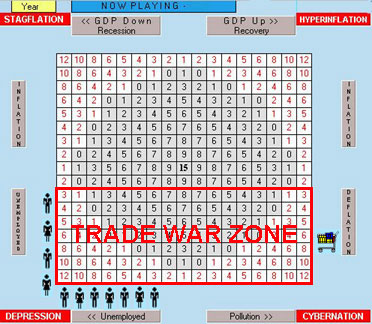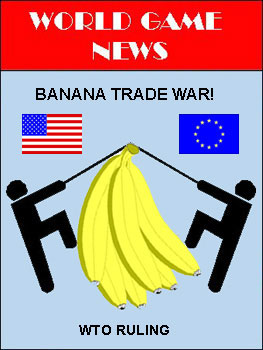
 April
1999 The United States and the European Union have been embroiled
in a trade dispute over bananas for the past six years. One of
the
many ironies of this story is that neither the US nor the EU grows
bananas.
So how did they get involved in this conflict? It began when the
EU imposed an elaborate banana quota system favoring growers in their
former
Caribbean colonies over those in Central America, where US owned
companies
like Chiquita Brands are located.
April
1999 The United States and the European Union have been embroiled
in a trade dispute over bananas for the past six years. One of
the
many ironies of this story is that neither the US nor the EU grows
bananas.
So how did they get involved in this conflict? It began when the
EU imposed an elaborate banana quota system favoring growers in their
former
Caribbean colonies over those in Central America, where US owned
companies
like Chiquita Brands are located.
The US sued on behalf of its American owned companies in Central
America,
claiming that the EU policy violated the World Trade Organization (WTO)
non-discrimination clause and resulted in over $500 mn in lost banana
sales.
While waiting for the WTO to rule, the US imposed tariffs on luxury
goods
from Europe. Under US trade law, the president can impose trade
sanctions
on unfair trading nations.
Early in April the WTO ruled in favor of the US. The ruling authorized US trade sanctions in the amount of $190 mn, far below the original amount of damage claimed by the US. The test now is whether either side will comply with the ruling. It's an issue of regional autonomy vs. globalism.
Although the US can claim a small victory from the WTO ruling, there are few winners in a trade dispute. The big losers are the European and American consumers. The Germans, for example, are big consumers of bananas. German consumers lost when banana imports were diverted from low cost Central American producers to less efficient producers in the former European colonies. The American consumers lost when punitive tariffs were imposed on Scottish cashmere and French handbags.
Bananas are not a big deal. However, the real danger is that the small skirmish might escalate to an all out trade war between the two economic superpowers. While that is unlikely, it is not unprecedented. Countries are most likely to engage in protectionist trade policies when they are in recession and have high unemployment. (See Trade War Zone in picture below).

Trade restrictions, tariffs, and deliberate currency devaluations have the short-term effect of diverting supply and demand to domestic producers. This raises prices, but inflation is not usually an issue when a country has high unemployment. The problem is that nobody wins when all countries engage in protectionist policies. In the worst case scenario, they all lose in the long-run.
That is precisely what happened to the world in the early 1930s. Many countries were in the Depression corner of the playing field in The World Game of Economics. In an effort to get out of the corner, the US passed the Smoot Hawley Tariff Act, which raised the average tariff rate to over 50% ad valorem on protected merchandise. Within weeks, more than 20 nations retaliated with tariffs of their own on a wide variety of US exports. Trade around the world devolved to a trickle, and everybody stayed in the depression.
It was this bitter experience which encouraged the formation of the General Agreement on Tariffs and Trade (GATT) at the end of World War II. The GATT was successful in significantly reducing average tariff rates around the world, and world trade has flourished in the second half of this century as a result. GATT was transformed into the WTO in 1995. One of the major functions of the WTO is to settle international trade disputes like the banana issue. However, the WTO is not a government, and individual nations retain the right to determine trade policies which conform to their own national interests as well as their international obligations.